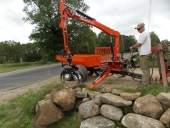posted 2 years ago
We just had a lesson in this play out across a large chunk of the North Island. When Cyclone Gabrielle strafed the East Coast and Hawkes Bay regions last month, the wind and flooding (exacerbated by all the logging slash coming down the rivers) took out a huge amount of infrastructure. Communications were especially vulnerable.
Since most people these days have ditched their land lines, when the cell towers went dark because their batteries were only good for a few hours off grid, they had no means of contact with the outside world. Internet connections were down because the fibre optic trunk lines to other regions were severed. And even the cell towers that had generator power were still useless, because their backhauls to the networks ran on the same fibre ducts.
We're almost four weeks in the wake of that disaster and there are still a lot of gaps in coverage in the more remote areas. At least we now know the whereabouts of everyone who was registered as missing after the storm went through (and that number was in the thousands at one point).
The good old copper telephone network was reliable because it was built to withstand these sorts of things, and also because governments in most industrial countries required the telcos to build in redundancy and be able to keep the lines active. Things like electromechanical switches and massive NiFe battery banks were deployed a century ago and in some exchanges the batteries are still there. The whole system was based on kit with a service life measured in decades.
Unfortunately for us, deregulation of our telecom industry meant that the network operator, who bought the system from the public back in the '90s and let it slowly rot in place, had fewer requirements to maintain the copper. So when they rolled out fibre to (most) of the country, they also rolled back their support for deteriorating analog lines. We dropped ours years ago in favour of VOIP over radio internet, which for us was more reliable than the telco copper had been. Our old land line struggled to deliver ADSL and was full of noise, but the company refused to fix it, claiming that it was within the specs that they were legally required to meet.
And like the problem of the stranded cell towers, we now have the issue of copper exchanges hooked to fibre backhauls, which tend to run alongside transportation corridors. The weak link here is bridges, because we are getting more and bigger flood events, and in areas where there's lots of forestry bridges are one of the first things to go when thousands of tons of logs jam up on the pilings...and yes, this is also a failure of regulation because the forestry operators have gotten away with this for years.
So, even if you have good backup power, the chain is only as strong as its weakest link. In places where wind, fire, or flood could take out your uplink, the best option is probably radio. There are lots of ways to manage this with repeaters and mesh networks, but unless there is a requirement from on high, the companies providing the service aren't going to race to deploy them. It may come down to federated DIY systems in vulnerable places, where communities pitch in to keep themselves "on the air." During disruptions to the commercial networks we could keep essential comms up, albeit with less bandwidth and more latency (stay off Youtube and Tiktok until normal service resumes...text is far more economical).









 2
2




 4
4




 3
3











 3
3










 1
1








